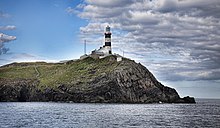Old Head of Kinsale

Lighthouse on the Old Head near Kinsale, County Cork
|
|
|
Ireland
|
|
| Location | County Cork, Ireland |
|---|---|
| Coordinates | 51°36′16.8″N 8°32′00.4″W / 51.604667°N 8.533444°W |
| Year first constructed | 1853 |
| Construction | masonry tower |
| Tower shape | cylindrical tower with balcony and lantern |
| Markings / pattern | white and black horizontal bands |
| Height | 30 metres (98 ft) |
| Focal height | 72 metres (236 ft) |
| Range | 20 nautical miles |
| Characteristic | Fl (2) W 10 s. |
| Fog signal | 3 blasts every 45 s |
| Admiralty number | A5710 |
| NGA number | 6340 |
| ARLHS number | IRE-055 |
| Ireland number | CIL-0200 |
Coordinates: 51°36.16′N 8°32.00′W / 51.60267°N 8.53333°W
The Old Head of Kinsale (in Irish, An Seancheann) is a headland near Kinsale, County Cork, Ireland. An early lighthouse was established here in the 17th century by Robert Reading. The area is the nearest point of land (11 miles/18 km) to where the RMS Lusitania was sunk in 1915.
Today the Old Head of Kinsale is popular with golfers who come to play on its 18 Hole golf course that opened in 1997.
The old head of Kinsale was formed by differential erosion. An outcrop of hard sandstone is lodged between two layers of shale. The shale is eroded by marine action at a faster rate than the sandstone. The sandstone anticlines were much more resistant to erosion than the slate filled synclines. Thus over time the headland was formed.
Since the golf course opened, access to the Old Head of Kinsale has been restricted to golfers and guests only, and there has been a long-running campaign for the restoration of public access organised by the Free the Old Head of Kinsale Campaign. This campaign has mainly taken the format of "People's Picnics", some of them involving "incursions" onto the headland and holding the picnics at the Old Head lighthouse.
...
Wikipedia

